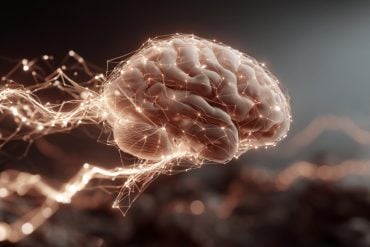Summary: Researchers report meditation and yoga are more effective at reducing stress than Chi in soldiers. Additionally, those who meditate showed stronger executive control.
Source: U.S Army Research Laboratory.
For a thousand years, people have reported feeling better by meditating but there has never been a systematic study that quantified stress and how much stress changes as a direct result of meditation until now.
U.S. Army Research Laboratory researchers spent a year collaborating with a team of scientists from the University of North Texas to develop a new data processing technique that uses heart rate variability as a sensor to monitor the state of the brain. Their findings are reported in a paper published in the June edition of Frontiers in Physiology.
Healthy heartbeats have irregularities built into them with a slight random variation occurring in the time interval between successive beats. The sinus node, or the heart’s natural pacemaker, receives signals from the autonomic or involuntary portion of the nervous system, which has two major branches: the parasympathetic, whose stimulation decreases the firing rate of the sinus node, and the sympathetic, whose stimulation increases the firing rate. These two branches produce a continual tug-of-war that generates fluctuations in the heart rate of healthy individuals.
Heart rate variability provides a window through which we can observe the heart’s ability to respond to external disturbances, such as stress, said Dr. Bruce West, the Army’s senior research scientist for mathematics.
He said it turns out that the HRV time series is very sensitive to changes in the physiological state of the brain and the new data processing system, called dynamic subordination technique, can quantify the changes in HRV and relate these directly to brain activity, such as produced by meditation. Thus, the DST has quantified the level of stress reduction produced by meditation and offers the potential to quantify such things as the inability to concentrate and sustain focus, impatience, impulsiveness and other dysfunctional properties that severely limit a soldier’s ability to do his job.
Stress modulates the autonomic nervous system signals, which in turn disrupts normal HRV and therefore the stress level can be detected by processing HRV time series.
Through a new method of processing HRV time series data, the researchers developed a way to measure the change in the level of stress provided by meditation. This measure assigns a number to the level of variability of heartbeat interval time series before and during meditation. This number indicates precisely how much stress is alleviated by control of the heart-brain coupling through meditation.
In the article, Rohisha Tuladhar, Gyanendra Bohara, and Paolo Grigolini, all from the University of North Texas and Bruce J. West, Army Research Office, propose and successfully test a new model for the coupling between the heart and brain, along with a measure of the influence of meditation on this network. Traditional models of biofeedback focus on the coherent behavior, assuming a kind of resonance, however the new approach includes both periodicity and complexity.
The research team compared two schools of meditation and determined that Yoga, over Chi meditation, is more effective in reducing stress and can show by how much. They also found that the long-term practice of meditation has the effect of making permanent the meditation-induced physiologic changes. Moreover that meditators show a stronger executive control, that is, the ability to carry out goal-oriented behavior, using complex mental processes and cognitive abilities.
Many military historians believe battles, even wars, have been won or lost in the warrior’s mind, long before any physical conflict is initiated. Learning how to circumvent the debilitating psychological influence of stress requires that we have in hand a way to quantify its influence, in order to gauge the effectiveness of any given procedure to counteract its effects, explained West, who’s a Fellow with the American Physical Society, American Association for the Advancement of Science and ARL.

Historically, one purpose of meditation has been to reduce stress, however, the Army’s long-term goal is to use it to mitigate the effects of post-traumatic stress disorder, or PTSD. West said the potential for this to succeed has been dramatically increased with the new ability to quantify the degree of effectiveness in stress reduction using different meditation techniques.
From a physiological perspective, meditation constitutes a coupling of the functionalities of the heart and brain. We are only now beginning to understand how to take advantage of the coupling of the two to measure stress reduction by applying the methods of science and data analysis to HRV time series.
Our research focus is on changes in physiologic processes, such as stress level. It is the most direct measure of the effectiveness of meditation in reducing stress to date and compliments an existing ARL program on determining the efficacy of mindfulness meditation stress reduction, which quantifies the influence on different task performance measures, such as changes in PTSD symptoms, West said.
This early research could guide the design and testing of new interventions for improving warrior readiness and resilience, as well as reducing symptoms of PTSD.
Source: T’Jae Ellis – U.S Army Research Laboratory
Publisher: Organized by NeuroscienceNews.com.
Image Source: NeuroscienceNews.com image is credited to Dr. Valerie Rice.
Original Research: Open access research for “Meditation-Induced Coherence and Crucial Events” by Rohisha Tuladhar, Gyanendra Bohara, Paolo Grigolini and Bruce J. West in Frontiers in Physiology. Published May 29 2018.
doi:10.3389/fphys.2018.00626
[cbtabs][cbtab title=”MLA”]U.S Army Research Laboratory “Stress Levels Change After Meditation.” NeuroscienceNews. NeuroscienceNews, 21 June 2018.
<https://neurosciencenews.com/stress-meditation-9408/>.[/cbtab][cbtab title=”APA”]U.S Army Research Laboratory (2018, June 21). Stress Levels Change After Meditation. NeuroscienceNews. Retrieved June 21, 2018 from https://neurosciencenews.com/stress-meditation-9408/[/cbtab][cbtab title=”Chicago”]U.S Army Research Laboratory “Stress Levels Change After Meditation.” https://neurosciencenews.com/stress-meditation-9408/ (accessed June 21, 2018).[/cbtab][/cbtabs]
Abstract
Meditation-Induced Coherence and Crucial Events
In this paper we emphasize that 1/f noise has two different origins, one compatible with Laplace determinism and one determined by unpredictable crucial events. The dynamics of heartbeats, manifest as heart rate variability (HRV) time series, are determined by the joint action of these different memory sources with meditation turning the Laplace memory into a strongly coherent process while exerting an action on the crucial events favoring the transition from the condition of ideal 1/f noise to the Gaussian basin of attraction. This theoretical development affords a method of statistical analysis that establishes a quantitative approach to the evaluation of the stress reduction realized by the practice of Chi meditation and Kundalini Yoga.







